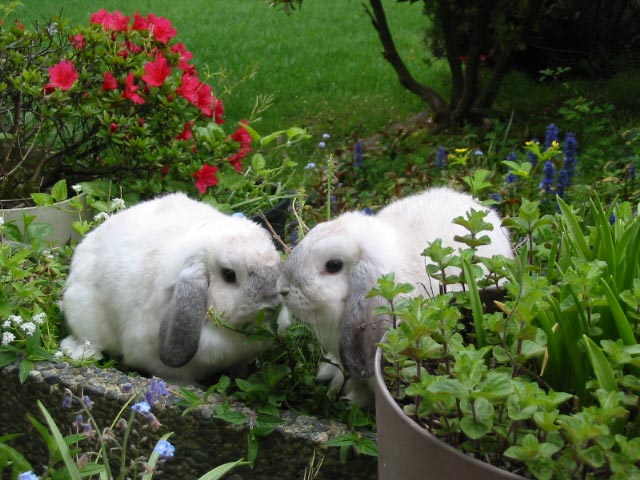

Rabbit Advocacy
Group of BC 
Heat Kills!
Protect Your Rabbit From Heatstroke
- Rabbits do not tolerate hot weather well, so providing protection against heatstroke is a must. Rabbits can overheat at temperatures of 26 degrees Celsius and around 80 degrees Fahrenheit. They will need your immediate attention.
- Normal body temperature is 38.5 to 40 C and 101.3 to 104 F.
Rabbits are cooled primarily by respiration, with the ears playing an important part in thermoregulation. In fact, about 80% of heat dissipation occurs through the evaporation of moisture during breathing, with the ears creating a radiator effect.
Rabbits cannot tolerate heat because:
a) they have dense fur coats
b) their only sweat glands are on their lips so they don't perspire well
c) unlike other animals, they cannot pant effectively to dissipate heat
d) they do not drink when they become overheated or dehydrated
Signs of heatstroke include panting, rapid and shallow breathing, weakness, increased or erratic respiratory rate, incoordination, enlarged blood vessels in the ears, and lying flat in a stretched out position. The animal may have convulsions before fading into a coma. Death follows rapidly.
If the rabbit is exhibiting symptoms of heat stress, move him or her to a cool area and place a fan nearby to create a gentle breeze. Mist the ears and body with cool water. Never use ice as this inhibits cooling and never bathe in cold water as the bunny may go into shock. Emergency care may be required so if in doubt, donít hesitate, go immediately to a veterinarian.
To prevent a tragedy always keep your rabbit safe and protected. This can include keeping their living quarters away from heat sources and out of direct sunlight. Ensure there is always good air movement and that fresh drinking water is provided. Vegetables also help in keeping rabbits hydrated, and be aware that overweight, incapacitated, and aged animals are particularly sensitive.
Transport rabbits in air-conditioned vehicles only, and NEVER leave them in a vehicle on a warm day, even if the windows are open. Not even for a minute! This can be fatal.
Rabbit Advocacy's ad for The Province, July 29, 2009.

Rabbit Advocacy's online "Heat Kills" ad campaign can be seen on the home page of Vancouver Sun (vancouversun.com) from August 6 -20, 2009.
Rabbits & Weather
Sunlight
Rabbits cannot handle direct sunlight for very long at all. To them 80 degrees F is hot. Just a few minutes in full sunlight can kill them. It causes them to overheat rapidly. Make sure your rabbit always has a shaded area that it can get to. It is safest to move your bunnies to a cool spot in the home while the weather is hot. Windows can trap heat as the sun shines in.
Cold Weather
Rabbits usually handle cold weather a lot better than they do hot weather. So long as they are kept out of the wind and are kept dry, they usually do fine.
Rain
A wet rabbit is a rabbit that is more prone to getting ill or dying, especially if there are drafts or there is cold weather. Keep your rabbit out of the rain, and make sure s/he does not get wet. If s/he does get wet, dry s/he off right away. A little water on the surface of the coat will not harm the rabbit, so long as it has not reached the under layer of fur called the "undercoat." If it has reached the undercoat, dry well. Also watch for signs of illness in the next few weeks.
Wind
Drafts are one of the most common weather-related killers of rabbits. Make sure your rabbit is out of drafts, or at least has a place where it can get out of drafts. Wind chill can be very deadly.
Visit our Rabbit Issues page for more about rabbits
See more News/PSAs
